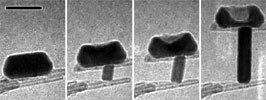
The four panels above show a time series of TEM video images spanning 60 seconds. The nanocrystal ram grows from near zero displacement to an extension of about 150 nm, as shown by the size bar. In panel (a), two multiwalled nanotubes (MWNTs) lie in contact with one another. A reservoir of indium atoms (dark object) rests on the top nanotube. Initially, all of the metal nanocrystal atoms are in the atomic reservoir, which, in this case, is located on the upper, movable MWNT, rather than the lower, stationary MWNT. In (b) the nanocrystal ram has begun to grow, separating the two MWNTs. In (d), the ram extension exceeds 125 nm.
APPLICATIONS:
- A variety of actuator functions in MEMS and NEMS, e.g. opening and closing microfluidic valves or electric relays, adjusting optical mirrors
- Activating light switches in all-optical networks
ADVANTAGES:
- Compatible with semiconductor processes
- Several orders of magnitude more powerful per unit volume than a gasoline engine or a biomotor
- Scales well with decreasing size
- Fully synthetic and frictionless
- Maintains specified extension at rest
- Precision, low voltage operation (<5 V)
ABSTRACT:
Berkeley Lab’s extremely powerful, fully synthetic nanoscale motor or actuator allows direct electronic control of linear movement at atomic length scales. The motor can be integrated with semiconductor processes, maintains its extension in the rest state, scales well with decreasing size, and is frictionless. Its calculated power generation per unit volume is 800 GW/m3, approximately 10,000 times greater than that of a 2004 Toyota Camry V6 engine (50 MW/m3) or a biomotor (30 MW/m3).
The Berkeley Lab actuator, designed by Alex Zettl, Shaul Aloni and Brian Regan, uses surface diffusion directed by an external voltage source to transport atoms or nanoparticles to grow and deplete a nanocrystal. The speed and degree of linear motor action can be electronically controlled, atom by atom. The length of the ram is adjustable from zero to over 100 nm, with extension speeds exceeding 1500 nm/s. The large power-to-size ratio of this wear-free motor, along with its low voltage requirement, scalability, and other unique features, make it a promising replacement for some MEMS actuators currently in use.
STATUS:
- Issued U. S. Patent # 7,863,798. Available for licensing or collaborative research
REFERENCE NUMBER: IB-2011
SEE THESE OTHER BERKELEY LAB TECHNOLOGIES IN THIS FIELD: